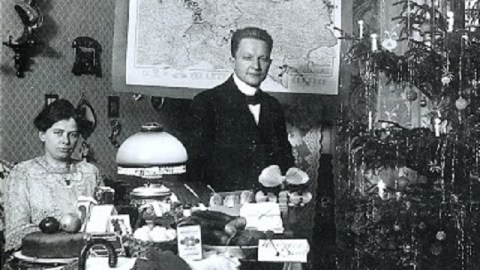How Picturing Christmas Becomes Picturing the Passing of Time

Exchanging Christmas cards each year with rarely seen friends and extended family always brings the annual revelations of photographs. Infants suddenly join the crowd as parents and siblings grow older around them. Kids I haven’t seen in years or perhaps never stubbornly insist on changing despite the picture of them I have fixed in my mind. Even hearing that one friend’s daughter had been accepted into her college of choice couldn’t transform her into anything but the precocious 5 year old still carrying on a conversation in the back of my imagination. Now my two sons make that annual mental pilgrimage in pictures for our friends and far-flung family. For me, the picturing of Christmas has been and will always be a way of picturing the passing of time—a fascinating sign post that illustrates the power of pictures. (Feel free to insert Hanukkah, Kwanzaa, New Year’s Eve, or whatever holiday you cherish here and for all the following.) Perhaps no better example of that yuletide time machine exists than the Christmas photographs of Richard and Anna Wagner, a German couple who posed for Christmas card photos for four decades. Watching them rise and fall with the fortunes of their country in the first half of the twentieth century reminds us of how Christmas allows us to freeze frame life.
We don’t know much of the Wagners aside from what their photos tell us. A passionate amateur photographer, Richard bought the latest cameras regardless of cost—a not unusual habit in those still early days of photography. He worked for a railway company, climbing the corporate ladder from youth to retirement. Anna and Richard married in the nice round year of 1900 and moved into a simple apartment in Essen, Germany. The newlyweds chose an action shot for their first Christmas card photo (click on the hot links to see the images). Richard trims the tree as Anna plays with their cat. On the table before them are their Christmas gifts to one another, including the album Anna gave to Richard that year that could hold 200 postcard photographs. Richard collected their annual Christmas card photos in that album, which was found in an attic in the former Soviet-controlled East Berlin in the 1990s and published soon thereafter. (The photos are now stored in the Heimatmuseum in Berlin.)
With only a few interruptions, the Christmas card photo tradition continued until 1942. Furnishings in the background change with the times, just as Richard and Anna themselves age gracefully. The material possessions they found the greatest pride in appear annually, as can be seen in their 1909 photo, taken just two years before they moved to the two-and-a-half room Berlin apartment they would rent out for the rest of their lives. In many of the photos a portrait of Kaiser Wilhelm II hangs over the sofa, his indomitable mustache marking his status as the last of the German emperors until his death in 1941, but clues to the Wagners’ political views elude us. Richard clearly took pride in his country, going so far as to pose in front of a map indicating German advances in World War I in the 1915 photo (detail above, full photo here). Too old to serve himself in World War I, Richard must have followed vicariously through the newspaper accounts. His nationalism, however, didn’t blind him to the realities of war. With a striking note of honesty, Richard and Anna posed in front of the tree in 1917 wearing heavy winter coats to capture the deprivations of the time as Germany’s war fortunes reversed—a steep fall from the heady days just two years before. No map is necessary to show you the war’s progress now.
Richard and Anna survived that first world war. In 1927, times are good again, at least for the Wagners, as can be seen by Anna posing proudly with the newfangled vacuum cleaner in that year’s picture. Finally rising slowly from the shackles of the Treaty of Versailles’ punitive economic conditions imposed on Germany, the country made it to its feet only to be blindsided by the 1929 Stock Market Crash that set off the worldwide Great Depression. The Wagners’ photos convey the sense of unease of those years, the pervasive anxiety that Hitler capitalized on in his rise to power. You won’t find a sign of affiliation with Nazism in the Wagners’ photos. The steely-eyed Kaiser continues to glare down from above the sofa. That’s not to say that they didn’t jump on the bandwagon as Hitler restored Germany in the run-up to World War II, but at least there’s no clear sign of it. I wonder if the Wagners would lose some of their grandparentish charm if Adolf’s mustache replaced Wilhelm. Well into old age, the Wagners most likely accepted the Nazis rise, if not their ideology, as a good thing for their country that had seen such hard economic times.
In one of their last photos, from 1940, Richard and Anna sit at a table weighed down by that year’s gifts. The tree behind them almost sags with the tinsel hung on it, just as they seem to sag into their seats with the weight of decades behind them. Their smiles seem genuine and comfortable. After four decades, the wedding cake still tastes sweet. Whereas Richard in previous years’ photos sometimes seemed dour and intimidating—often standing in a pose of dominance while Anna sat demurely to the side—here they sit on an equal level, partners in life. One last photo of them together in 1942 shows a near-empty bottle on the table surrounded by a modest meal—a stark contrast to the feasts and largesse of the past. It’s as if Richard realized that the end was approaching—both for the German Reich and for their lives together. The bottle was nearly finished, but they were finishing it together.
Richard took one last photo of Anna alone in June 1945, just weeks after the end of the war in Europe. Visibly thinned by the food shortages of the war, Anna seems almost ghostly. She died that August. Richard died 5 years later, a few weeks before Christmas of 1950. No Christmas photos of those last lonely years survive, if they ever existed at all. Nearly half a century would pass before the collection would be discovered and enter into a museum as a remarkable social document of social history told on an intimate scale.
The Wagners never had children. Despite the fullness of their photos, that childlessness makes them seem tragically empty to me, who equates Christmas with children, perhaps unfairly. Not having children, however, also meant they never had a son or daughter to feed to the meat grinder of either war Germany waged, so maybe that was some consolation to them, assuming that they even wanted to have children. The danger of reading the Wagners’ photos is imposing your own desires and hopes onto them. In the end, they are what they are, photos of time passing and two people living (and dying) together.
Richard printed out his postcards as stereoscopes—dual images on one card that, when looked at through a viewer, gave the illusion of three dimensionality. Friends and family could feel like they were right there in the Wagners’ living room, able to touch the tinsel on the tree, chided by the Kaiser, and maybe even trying out Anna’s new vacuum. I think all Christmas photos have a similar three-dimensional effect or, rather, a four-dimensional effect. The extra dimension of time embedded in each photo we see this holiday season reminds us of how fleeting each moment truly is. Embed it in whatever amber you choose as technology permits, time always wins in the end. We’ll always lose that race, but Christmas and Christmas card photos at least allow us to pause for a moment and to reflect, remember, and rejoice.




